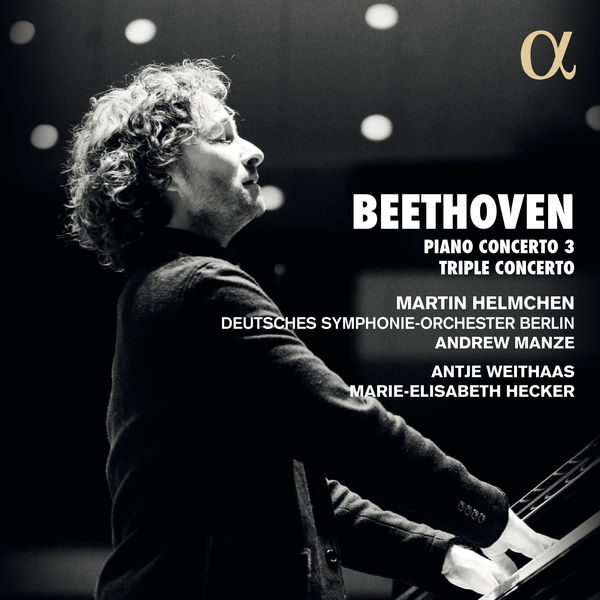
Martin Helmchen – Beethoven – Concerto No.3 & Triple Concerto (2020)
FLAC (tracks) 24-bit/96 kHz | Time – 01:09:58 minutes | 1,22 GB | Genre: Classical
Studio Master, Official Digital Download | Digital Booklet, Front Cover | © Alpha
German pianist Martin Helmchen continues his journey through Beethoven’s piano concertos with the Deutsches Symphonie-Orchester and Andrew Manze. In the Third Concerto, published in 1804, Beethoven seems to be moving away from the Mozartian model and inaugurates his ‘middle period’, using the minor mode to depict a distress and heartache that are certainly not unconnected with the famous ‘Heiligenstadt Testament’, which he wrote in 1802 to record his growing deafness. Martin Helmchen is joined by two partners with whom he performs a great deal of chamber music – violinist Antje Weithaas and cellist Marie-Elisabeth Hecker – to record the Triple Concerto, also written during the composer’s so-called ‘heroic’ period.
This third and final part of the new complete works of Beethoven’s Piano Concertos on Alpha Classics is a real highlight coming at the end of the Year of Beethoven (2020 marks the composer’s 250th birthday). It reveals an unparalleled elegance and wonderfully radiant phrasing.
The Concerto for Piano, Violin and Cello stands out immediately. The pianist Martin Helmchen is joined by two of his regular chamber music partners for the occasion – violinist Antje Weithaas and cellist Marie-Elisabeth Hecker. Helmchen engages in a fluid dialogue with his companions and the three musicians avoid battling with each other; something you often find in many historical recordings. What’s more, they infuse their playing with the score’s chamber music spirit – a style that was often that was often overlooked by the Bonn Master. Perhaps it would be better to view this setup as a trio with orchestral accompaniment. After all, the first sonatas with cello (Op. 5 for example) and violin (Op. 12) are actually more like Sonatas for keyboard with keyboard accompaniment. The three musicians seem to think so too, as does the great Andrew Manze. The sound recording, on the other hand, does not give the keyboard pride of place and instead gives the two string soloists the opportunity to express the work’s incredibly lyrical side (Largo).
The Third Concerto, published in 1804, inaugurates the composer’s “middle period”. He moved away from the model of Mozart, although the second movement (the moving Largo, which was perhaps written in the wake of the Heiligenstadt Testament) is still a marvellous homage to his elder. That said, it’s clear that the concert piano has entered a new era with the opening of Allegro con brio.
Following the outstanding first two concertos, Martin Helmchen never forces things in the Third Concerto. It’s never totally Mozart and never imperial either (with regards to the last concerto, The Emperor). As a stylistic idea that few pianists express today, this now-completed complete work is one of the most striking around. – Pierre-Yves Lascar
Tracklist
1. Martin Helmchen – I. Allegro con brio
2. Martin Helmchen – II. Largo
3. Martin Helmchen – III. Rondo. Allegro – Presto
4. Antje Weithaas – I. Allegro
5. Antje Weithaas – II. Largo
6. Antje Weithaas – III. Rondo alla Polacca
Download:
mqs.link_MartinHelmchenBeeth0venC0ncert0N0.3TripleC0ncert020202496.part1.rar
mqs.link_MartinHelmchenBeeth0venC0ncert0N0.3TripleC0ncert020202496.part2.rar




















![Martin Helmchen - Bach: Six Partitas (2024) [FLAC 24bit/48kHz] Martin Helmchen - Bach: Six Partitas (2024) [FLAC 24bit/48kHz]](https://imghd.xyz/images/2024/05/04/kbh3tok8vulza_600.jpg)
![Martin Helmchen - Schumann: Novelleten & Gesänge der Frühe (2022) [FLAC 24bit/96kHz] Martin Helmchen - Schumann: Novelleten & Gesänge der Frühe (2022) [FLAC 24bit/96kHz]](https://i0.wp.com/imghd.xyz/images/2022/05/11/ipg2l7d4acu0b_600.jpg?resize=500%2C500&ssl=1)
![Martin Helmchen, Deutsches Symphonie-Orchester Berlin - Beethoven - Pianos concertos 1 & 4 (2020) [FLAC 24bit/96kHz] Martin Helmchen, Deutsches Symphonie-Orchester Berlin - Beethoven - Pianos concertos 1 & 4 (2020) [FLAC 24bit/96kHz]](https://getimg.link/images/imgimgimg/uploads/2020/07/lncCIRr.jpg)
![Martin Helmchen - Schubert, F. Piano Sonata No. 20, D. 959 6 Moments Musicaux, D. 780 (2008) [FLAC 24bit/96kHz] Martin Helmchen - Schubert, F. Piano Sonata No. 20, D. 959 6 Moments Musicaux, D. 780 (2008) [FLAC 24bit/96kHz]](https://getimg.link/images/imgimgimg/uploads/2021/07/FybvUWK.jpg)
![Martin Helmchen - Beethoven: Piano Concertos 2 & 5 “Emperor” (2019) [FLAC 24bit/48kHz] Martin Helmchen - Beethoven: Piano Concertos 2 & 5 “Emperor” (2019) [FLAC 24bit/48kHz]](https://getimg.link/images/imgimgimg/uploads/2020/04/MEiXdKx.jpg)
![Julia Fischer & Martin Helmchen - Franz Schubert Complete Works for Violin & Piano (2014) [DSF DSD64/2.82MHz] Julia Fischer & Martin Helmchen - Franz Schubert Complete Works for Violin & Piano (2014) [DSF DSD64/2.82MHz]](https://getimg.link/images/imgimgimg/uploads/2018/04/z5803Ao.jpg)
![Martin Helmchen - Schubert: Trout Quintet, Trockne Blumen Variations, Notturno (2009) [MCH SACD ISO + DSF DSD64 + Hi-Res FLAC] Martin Helmchen - Schubert: Trout Quintet, Trockne Blumen Variations, Notturno (2009) [MCH SACD ISO + DSF DSD64 + Hi-Res FLAC]](https://imghd.xyz/images/2024/06/23/00850f4e.webp)
![Martin Helmchen, Netherlands Chamber Orchestra, Gordan Nikolic - Mozart: Piano Concertos Nos. 13 & 24 (2007) [DSF DSD64/2.82MHz] Martin Helmchen, Netherlands Chamber Orchestra, Gordan Nikolic - Mozart: Piano Concertos Nos. 13 & 24 (2007) [DSF DSD64/2.82MHz]](https://getimg.link/images/imgimgimg/uploads/2018/03/eqwaOSj.jpg)
![Marie-Elisabeth Hecker & Martin Helmchen - Brahms: Cello Sonatas (2016) [FLAC 24bit/96kHz] Marie-Elisabeth Hecker & Martin Helmchen - Brahms: Cello Sonatas (2016) [FLAC 24bit/96kHz]](https://getimg.link/images/imgimgimg/uploads/2019/05/kQ55ZV7.jpg)
![Martin Helmchen - Beethoven: Diabelli Variations (2018) [FLAC 24bit/96kHz] Martin Helmchen - Beethoven: Diabelli Variations (2018) [FLAC 24bit/96kHz]](https://getimg.link/images/imgimgimg/uploads/2019/07/GHRs3uh.jpg)
![Martin Helmchen, Marie-Elisabeth Hecker & Antje Weithaas - Schubert: Arpeggione Sonata & Trio No. 2 (2017) [Qobuz FLAC 24bit/96kHz] Martin Helmchen, Marie-Elisabeth Hecker & Antje Weithaas - Schubert: Arpeggione Sonata & Trio No. 2 (2017) [Qobuz FLAC 24bit/96kHz]](https://getimg.link/images/imgimgimg/uploads/2018/07/sx08dNa.jpg)
![Martin Helmchen, Netherlands Chamber Orchestra, Gordan Nikolic - Mozart: Piano Concertos Nos. 15 & 27 (2013) [DSF DSD64/2.82MHz] Martin Helmchen, Netherlands Chamber Orchestra, Gordan Nikolic - Mozart: Piano Concertos Nos. 15 & 27 (2013) [DSF DSD64/2.82MHz]](https://getimg.link/images/imgimgimg/uploads/2018/03/Ch7Bzbl.jpg)
![Martin Helmchen - Messiaen: Vingt regards sur l’Enfant-Jesus (2019) [FLAC 24bit/48kHz] Martin Helmchen - Messiaen: Vingt regards sur l’Enfant-Jesus (2019) [FLAC 24bit/48kHz]](https://getimg.link/images/imgimgimg/uploads/2019/12/lIdvMB1.jpg)
![Juliane Banse & Martin Helmchen - Hindemith: Das Marienleben, Op. 27 (2018) [FLAC 24bit/96kHz] Juliane Banse & Martin Helmchen - Hindemith: Das Marienleben, Op. 27 (2018) [FLAC 24bit/96kHz]](https://getimg.link/images/imgimgimg/uploads/2018/10/LFCNvQf.jpg)